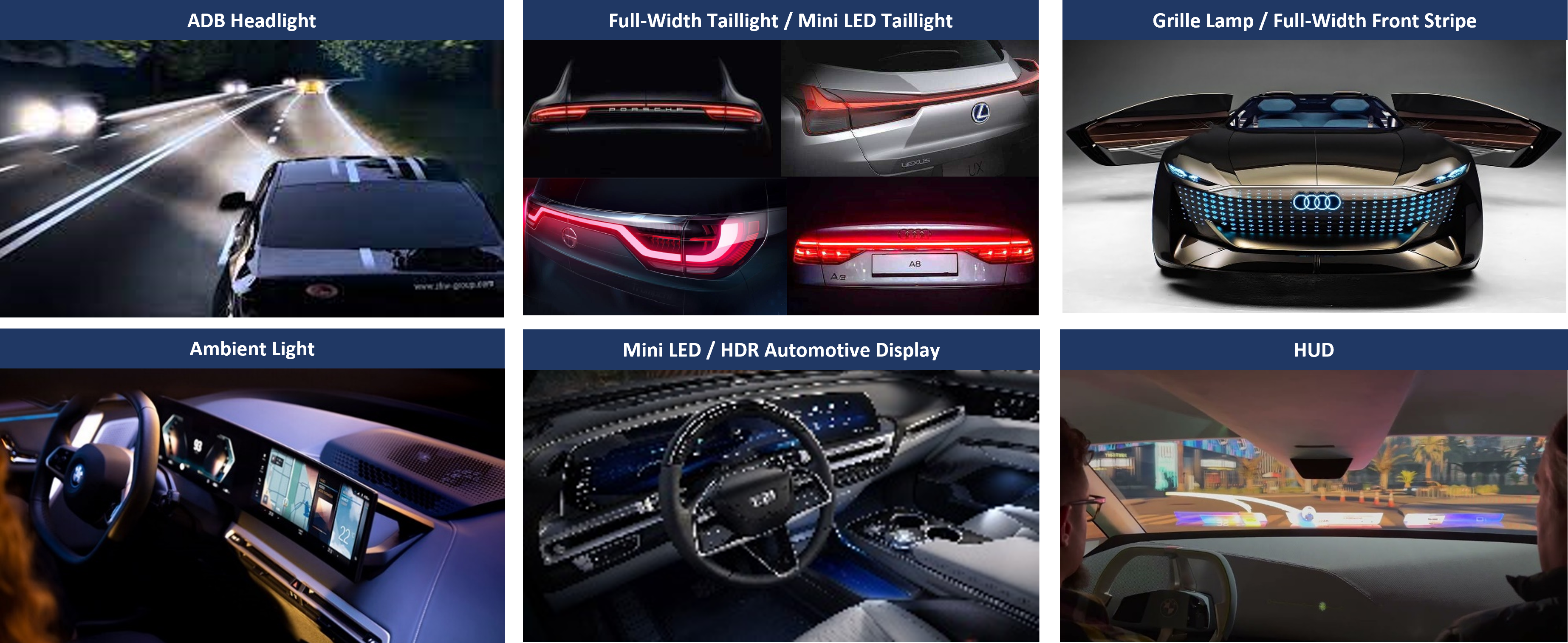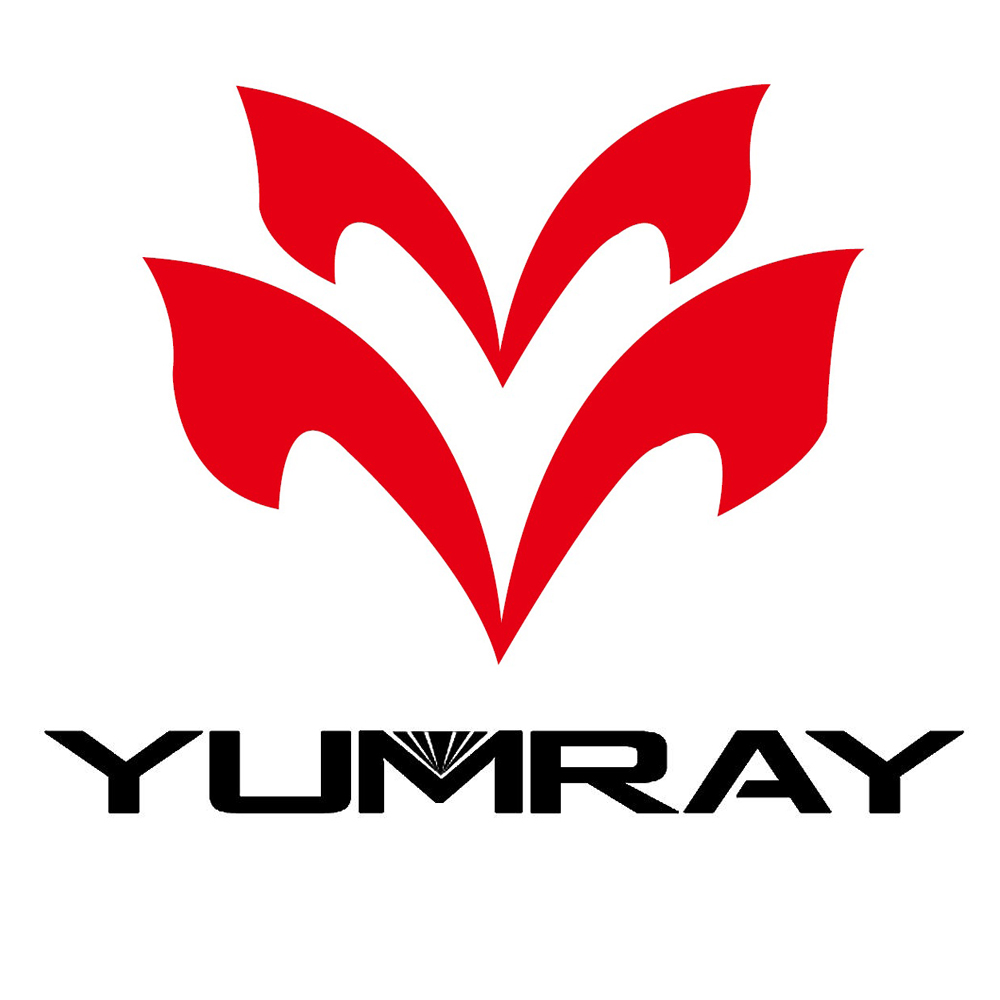【New Arrival】2023 Global Automotive LED Product Trend and Regional Market Analysis- Usher in Golden Era of Innovation
According to TrendForce’s analysis of car market demand in 2023, the global economy remains weak although inflation is slowing down in Europe and North America. Car manufacturers have been cutting vehicle prices to stimulate sales, but the act has caused fierce price competition. Due to fierce competition in the vehicle market, prices of automotive LEDs have dropped noticeably, consequently delaying several projects for LED product development. That being said, advanced technologies related to ADB headlights, Mini LED taillights, full-width taillights, logo lamps, and (intelligent) ambient lights will jointly push the automotive LED market value to USD 3.307 billion in 2023.

Automotive Lighting Will Concentrate on Personalization, Communication Display,
Driver Assistance, and Safety Upgrading in the Future
Automotive Lighting and Display Market Trend
1. Headlight
As TrendForce reported, the global penetration rate of LED headlights for passenger vehicles reached 70% in 2022, while that for electric vehicles even hit 92%; the two rates will likely grow to 77% and 94% in 2023, respectively.
Matrix LED is the mainstream design for ADB headlights. Through independent control of high-performance LEDs, the matrix layout helps expand drivers’ field of view at nighttime, reduce their reaction time when seeing an obstacle, and achieve better road lighting. Glare-free high beams help reduce discomfort for drivers of vehicles ahead, those of oncoming vehicles, and prevent pedestrians from being dazzled by headlights. With the use of Micro LED pixel array, the number of pixels available for accurate and independent digital control in an ADB headlight can be elevated to 10,000-100,000. The greater the pixel number, the more flexible the illumination area can be, hence an improvement in driving safety and flexibility for compliance with legal requirements among different regions and markets. In this way, automotive lighting manufacturers can save development, manufacturing, and logistics costs for different regions and markets. As TrendForce analyzes, the penetration rate of ADB headlights was only 3.7% in 2022, but it will likely jump to 17.0% in 2027.
2. Taillight
Taillights will come with more innovative designs. Full-width, Mini LED, and OLED-like taillights are currently the top three favorites among automakers and consumer. Future trends for automotive lighting—personalization, communication, and ADAS / autonomous driving—have given rise to Mini LED taillights. With high-pixel local dimming, Mini LED enables the taillight to dynamically align with the driving scenario by changing displayed images, allowing drivers of vehicles behind to recognize the car more easily and reduce the risk of car accidents. When the car is idle, the taillight then turns from a luminaire to a display providing vehicle-related information (e.g., charging status). As TrendForce reported, Mini LED taillights have been adopted by IM Motors and GWM (SAR Mecha Dragon), while Audi (Q5) will likely use the taillights as well.
3. Grille Lamp / Full-Width Front Stripe
Leading car manufacturers adopting grille lamps and full-width front stripes include Mercedes Benz (EQS), Volkswagen (ID.3 / ID.4), BYD, Xpeng (P5), Changan Ford (Mondeo), Sony (VISION-S 02), BMW (i7), Rolls-Royce (Spectre), Ford, General Motors, Stellantis, Lucid, and Li Auto. According to TrendForce’s survey, many EV models intend to adopt grille lamps in 2023. Grille lamp is moving from linear design towards full-width front stripe design.
4. Ambient Light
Automakers in Europe and China have been using ambient lights for years. Since 2022, intelligent ambient lights featuring RGB LEDs as built-in driver ICs have been applied to BMW’s vehicles and will be gradually extended to other European and Chinese models, with market value expected to grow year by year.
Cars equipped with intelligent ambient lights: Hongqi H9, ZEEKR 001, Leapmotor C01, BMW iX / i7 / XM, etc.
5. Automotive Display
Although inflation in Europe and North America has slowed down entering 2023, the global economy remains weak. Fierce price competition can be seen in the entire vehicle market after car makers cutting down vehicle prices with an effort to stimulate spending, while they are also slowing down the progress of Mini LED / HDR automotive display development. Instead, the manufacturers turn to focus on automotive lighting applications (headlights, taillights, grille lamps / full-width front stripes). With the rising trend for displays featuring HDR, local dimming, wide color gamut, and a curved screen, automakers have been racing to adopt Mini LED / HDR displays, including General Motors, Ford, BMW, Mercedes-Benz, Volvo, NIO, Roewe, Li Auto, and so on, with 2016 / 3030 / 2525 / 1515 LEDs.
6. HUD
According to TrendForce’s analysis, the HUD market shipment reached 9.52 million sets in 2022 thanks to steady growth in ADAS and smart cockpits. AR-HUD needs more time to thrive due to the requirement of camera and sensor integration. AR-HUD is estimated to capture a 33% market share in 2027, with high-end / electric vehicles in Europe and China being first targets.
AR HUD’s Picture Generation Unit (PGU) technologies include TFT-LCD, DLP, laser beam scanning LBS (MEMS), LCOS, and Micro/Mini LED. TFT-LCD remains the mainstream approach, while DLP and Micro/Mini LED are promising.

